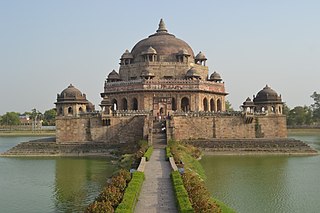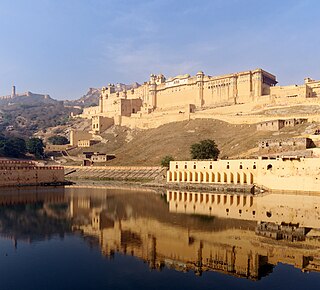
Mandu or Mandavgad is an ancient city in the present-day Mandav area of the Dhar district. It is located in the Malwa and Nimar region of western Madhya Pradesh, India, at 35 km from Dhar city. In the 11th century, Mandu was the sub division of the Tarangagadh or Taranga kingdom. This fortress town on a rocky outcrop about 100 km (62 mi) from Indore is celebrated for its architecture.

The Agra Fort is a historical fort in the city of Agra, also known as Agra's Red Fort. Mughal emperor Humayun was crowned at this fort in 1530. It was later renovated by the Mughal emperor Akbar from 1565 and the present-day structure was completed in 1573. It served as the main residence of the rulers of the Mughal dynasty until 1638, when the capital was shifted from Agra to Delhi. It was also known as the "Lal-Qila" or "Qila-i-Akbari". Before being captured by the British, the last Indian rulers to have occupied it were the Marathas. In 1983, the Agra fort was inscribed as a UNESCO World Heritage Site because of its importance during Mughal rule. It is about 2.5 kilometers (1.6 mi) northwest of its more famous sister monument, the Taj Mahal. The fort can be more accurately described as a walled city. It was later renovated by Shah Jahan.

Rohtas Fort is a 16th-century citadel located near the city of Dina in Jhelum district of the Punjab, Pakistan. Todar Mal, the minister of the Sur king Sher Shah Suri, supervised the construction of the fort which is now one of the largest and most formidable in Punjab.

Sasaram, also spelled as Shahasaram, is a historical city and a municipal corporation region in the Rohtas district of Bihar state in eastern India.

The Gahadavala dynasty also Gahadavalas of Kannauj was a Rajput dynasty that ruled parts of the present-day Indian states of Uttar Pradesh and Bihar, during 11th and 12th centuries. Their capital was located at Banaras in the Gangetic plains, and for a brief period, they also controlled Kannauj.

Amer Fort or Amber Fort is a fort located in Amer, Rajasthan, India. Amer is a town with an area of 4 square kilometres (1.5 sq mi) located 11 kilometres (6.8 mi) from Jaipur, the capital of Rajasthan. Located high on a hill, it is the principal tourist attraction in Jaipur. Amer Fort is known for its artistic style elements. With its large ramparts and series of gates and cobbled paths, the fort overlooks Maota Lake, which is the main source of water for the Amer Palace.
Jaya-chandra was a king from the Gahadavala dynasty of northern India. He is also known as Jayachchandra in inscriptions, and Jaichand in vernacular legends. He ruled the Antarvedi country in the Gangetic plains, including the important cities of Kannauj and Varanasi. His territory included much of the present-day eastern Uttar Pradesh and some parts of western Bihar. The last powerful king of his dynasty, he was defeated and killed in 1194 CE, in a battle near Yamuna against a Ghurid army led by Muhammad of Ghor.

The Fort of Gwalior or the Gwalior Fort is a defence hill fort in Gwalior, India. Mughal Emperor Babur called it the "pearl amongst the fortresses of Hind" because of its impregnability and magnificence and it has also been nicknamed the Gibraltar of India. The history of the fort goes back to the 5th century or perhaps to a period still earlier. The old name of the hill as recorded in ancient Sanskrit inscriptions is Gopgiri. The current structure of the fort has existed at least since the 8th century, and the inscriptions and monuments found within what is now the fort campus indicate that it may have existed as early as the beginning of the 6th century, making it one of India's oldest defence fort still in existence. The modern-day fort, embodying a defensive structure and two palaces was built by the Tomar Rajput ruler Man Singh Tomar. It has witnessed the varying fortunes of the Guptas, the Hunas, the Pratiharas, the Kachhwahas, the Tomaras, the Pathans, the Surs, the Mughals, the English, the Jats, and the Marathas represented by the powerful Scindia dynasty who have left their landmarks in the various monuments which are still preserved.
Bhabhanpura is a village on the outskirts of Varanasi city, located 7 km away from the heart of the city. Total population of the village is 2,992.

Narnala Fort or Narnala Qila Sarkar, also known as Shahnoor Fort, is a hill fortress in the Satpura Range of Vidarbh, Maharashtra, India, named after the Rajput Solanki Chaulukya Ruler, Raja Narnal Singh, also known as Narnal Singh Swami. It was renamed as "Shahnoor" by Islamic rulers but again acquired, rebuilt and got its name "Narnala" by ruler Rao Rana Narnal Singh Solanki, who migrated from Patan in Gujarat.

The Munger Fort, located at Munger, in the state of Bihar, India, is built on a rocky hillock on the south bank of the Ganges River. Its history is not completely dated but it is believed that it was built during the early rule of Slave dynasty of India. The Munger town where the fort is situated was under the control of Muhammad bin Tughluq of Delhi. The fort has two prominent hills called the Karnachaura or Karanchaura, and the other a built up rectangular mound deduced to be the location of a citadel of the fort with historical links. The fort had a succession of Muslim rulers (Khaljis, Tughlaqs, Lodis, Nawabs of Bengal, followed by Mughal rulers, till it was finally acceded to the British by Mir Quasim, after unseating his father-in-law Mīr Jafar on the grounds of old age, for a monetary reward negotiated by Vansittart. This deal involved payment by the East India Company's merchants of an ad valorem duty of 9 percent, against an Indian merchant's duty of 40%. The fort became a place of considerable importance to the British in Bengal till 1947.

Navlakha Palace, also known as Rajnagar Palace, is a royal palace in the town of Rajnagar, near Madhubani in Bihar, India. The palace was built by Maharaja Rameshwar Singh of Darbhanga.
Kharwar is a surname used by odh found in the Indian states of Uttar Pradesh, Bihar, Jharkhand, Chhattisgarh, Orissa and West Bengal in India and Sindh in Pakistan.
Chandradeva, also known as Chandraditya, was an Indian king from the Gahadavala dynasty. He ruled the Antarvedi country in present-day Uttar Pradesh, including Kanyakubja and Varanasi.

Govindachandra was the King of Kannauj from 1114 to 1155 and was a member of the Gahadavala dynasty.
Vijaya-chandra was an Indian king from the Gahadavala dynasty. He ruled the Antarvedi country in the Gangetic plains, which includes a major part of the present-day eastern Uttar Pradesh, including Varanasi. He probably also ruled some parts of western Bihar through his feudatories. He is believed to have repulsed a Ghaznavid invasion.
The Khayaravala dynasty, was a tribal kingdom that ruled parts of the present-day Indian states of Bihar and Jharkhand, during the 11th and 12th centuries. Their capital was located at Khayaragarh in Shahabad district. The dynasty ruled the Japila territory as feudatories of the Gahadavala dynasty of Varanasi. This is demonstrated by inscriptions which show land grants being made to the Khayaravalas.
Shri Pratapa was Khayaravala king in 13th century. There are inscription of Shri Pratapa in Rohtas of Vikram Samvat 1279. According to inscription he defeated a "Yavana" army; the "Yavana" here probably refers to a Muslim general. According to the inscription of Rohtas Fort, Shri Pratapa was descendant and successor of Pratapdhavala.
Akbarpur is a village in Rohtas block of Rohtas district, Bihar, India. Located on the bank of the Son river, a short distance east of the historic Rohtasgarh fort, Akbarpur is the headquarters of Rohtas block. As of 2011, it had a population of 9,236, in 1,491 households. Akbarpur covers 333 hectares and 6.73 km2.
Raja Gajpati Ujjainia, also known as Raja Gajpati Sahi was a ruler of Bhojpur belonging to the Ujjainiya dynasty.




















